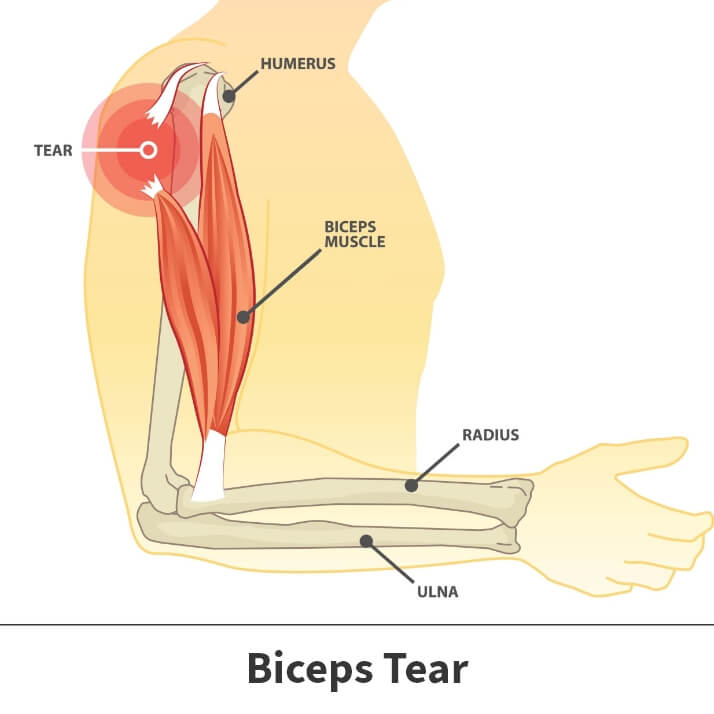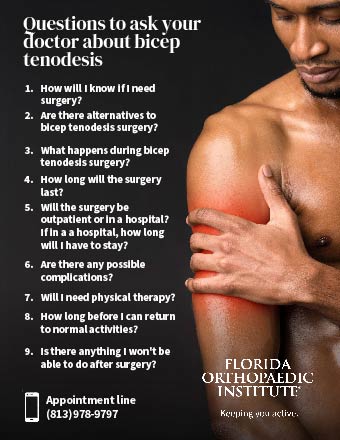Bicep tenodesis
Many of us fail to realize how important soft tissues are to our physical well-being. They connect our larger body parts like muscles and bones so we can perform basic but vital functions such as standing, sitting, and walking, in addition to grasping and holding objects.
Tendons are an example of these soft, connective tissues. One of the more critical examples is the bicep tendon, which connects shoulder bones with a protective layer of cartilage known as the labrum.
Shoulder joints continually move. Over time, such actions can increase the injury risk for surrounding features like bones, muscles, and soft tissues. One common problem impacting the shoulder is medically referred to as a bicep tendon tear. This injury might be corrected through a surgical procedure called bicep tenodesis.
Biceps tenodesis is a surgical procedure used to treat biceps tendonitis, also known as a biceps tendon tear. This procedure is recommended for people with biceps tendonitis who experience shoulder pain caused by inflammation that did not improve through nonsurgical treatment. It is also recommended for people who need to regain strength and mobility in their shoulder after a biceps tendon tear. The procedure involves removing and reattaching the biceps tendon’s damaged portions.
Anatomy

Your shoulder is a ball-and-socket joint that consists of 3 bones: your collarbone (clavicle), your shoulder blade (scapula), and your upper arm bone (humerus). The head of your upper arm bone fits into a rounded socket (the glenoid) in your shoulder blade. A combination of tendons and muscles, known as the rotator cuff, helps keep your arm bone centered in your shoulder socket.
The upper end of the biceps muscle has two tendons that attach it to the bones in the shoulder. The long head attaches to the top of the shoulder socket (glenoid). The short head attaches to a bump on the shoulder blade called the coracoid process.
About
Biceps tenodesis is a surgical procedure used to treat biceps tendonitis of the shoulder.
Biceps tendonitis, also known as a biceps tendon tear at the shoulder, occurs due to either abrupt injury or over time through overuse. The tendon itself can either tear partially or entirely. Most people will be able to continue living their lives without ever having to get surgery. A biceps tendon tear will cause you to lose some strength and mobility in your shoulder, but not enough to make a difference in your daily activities. But people who need to regain full mobility and strength of the shoulder will need to get surgery.
There are several different ways a biceps tenodesis procedure is done, but they all fit into two different categories: soft tissue and hard tissue techniques.
The two main soft tissue techniques are:
- Open keyhole procedure – An opening in the upper arm bone (humerus), also known as a keyhole, is created. Using small instruments, a rolled-up end of the bicep is stitched into place.
- The pitt technique – Two needles are used to develop an interlocking pattern of sutures to then tie the tendon to a shoulder ligament.
The two main hard tissue techniques are as follows:
- The biceps tendon is first detached. A hole is then created at the top of the arm bone. One end of the tendon is attached to the hole, while the rest of the tendon is secured by screwing it to the bone.
- The biceps tendon is detached and then reattached to a button slid into a hole at the top of the arm bone.
Your Florida Orthopaedic Institute surgeon will determine the best version of biceps tenodesis for you.
Bicep tendon injuries
These injuries develop gradually or follow some type of acute event. As you age, the everyday wear and tear on your shoulders may weaken the bicep tendon leaving it vulnerable to damage. Sudden incidents like falls, automobile accidents, and forceful contact sustained during athletic competition can also result in a bicep tendon injury.
Your risk increases as you reach middle age and older and take part in sports where competitors move their arms repeatedly over their heads, such as swimming, baseball or softball pitching, and tennis.
4 Common Causes of Pickleball Shoulder Pain
When is bicep tenodesis needed?
Your physician may recommend you consider undergoing the procedure if you experience moderate to severe pain, stiffness, and mobility limitations following other forms of less aggressive treatment like rest, ice application, and physical therapy, or if you have experienced a significant, acute bicep tendon tear.
Individuals whose injuries were so severe that the bicep tendon detached from the labrum are also candidates. In medical terminology, this event is labeled a SLAP tear. The term SLAP stands for superior labral tear from anterior to posterior.

Treatment
Preparation
In the hours leading up to the operation, recipients will usually be asked to refrain from consuming any food or beverages. Patients will be required to disclose any medications that they routinely use. Certain drugs might increase a recipient’s risk of complications or slow the healing process.
Patients who smoke will be advised to stop for at least the two weeks preceding the operation to reduce bodily inflammation, lessen the risk of complications, and speed up the healing process.
The procedure
Surgeons perform bicep tenodesis using two operational techniques.
The less invasive method is undertaken using a surgical tool called an arthroscope. Open surgery is the more traditional procedure.
Regardless of the procedure, recipients are first administered anesthesia. Once they are either put to sleep or their shoulder is comfortably numb, surgeons pull the injured tendon away from the labrum and re-position it on an adjacent shoulder bone.
Whenever possible, surgeons prefer the arthroscopic method because only small incisions are made, often resulting in less post-operative pain and a quicker recovery period.
The recovery process
It is not uncommon for recipients to feel a certain degree of post-surgical discomfort. Relief may come in the form of pain medications and the application of ice. The repaired shoulder is typically placed inside a movement-restricting device, like a sling, for several weeks following the operation.
Anywhere from three to four weeks following the procedure, you will likely go through a course of physical therapy. This treatment, often abbreviated as PT, is administered by a physical therapist in coordination with your surgeon. Physical therapy consists of specialized exercises designed to help you regain the shoulder strength and motion range you might have lost while injured.
It is difficult to establish specific recovery time frames. Everyone heals at their own pace, and several factors might play into the speed with which they recover. The estimated average recovery time is anywhere from four to six months.
Complications
Like any surgical procedure, bicep tenodesis does carry certain risks including:
- Blood clots
- Infection
- Nerve damage
- Post-surgical bleeding
- Chronic pain
The chances for such problems are minimized when experienced surgeons perform the operation in an adequately staffed and competent medical facility.
Success rates
Biceps tenodesis has a high success rate. More than 70% of those who undergo the operation report being symptom-free or experiencing a dramatic improvement in their condition. They report less pain, better flexibility, and strengthening of their shoulder and are able to return to their sports and activities. The procedure is thought to be most successful when performed within three months after the initial injury.

Read the questions to ask your doctor about bicep tenodesis.
Videos
Related specialties
- AC Joint Injuries
- Atraumatic Shoulder Instability
- Bankart Repair
- Broken Collarbone
- Bursitis of the Shoulder (Subacromial Bursitis)
- Calcific Tendinitis of the Shoulder
- Clavicle Fractures
- Dislocated Shoulder
- Fractures of the Shoulder Blade (Scapula)
- Glenoid Labrum Tear
- Impingement Syndrome of the Shoulder
- Little League Shoulder
- Reverse Total Shoulder Replacement
- Rheumatoid Arthritis (RA) of the Shoulder
- Rotator Cuff Tears
- Shoulder Arthritis
- Shoulder Arthroscopy
- Shoulder Injury: Pain in the Overhead Athlete
- Shoulder Replacement
- Shoulder Separations
- Shoulder Socket Fracture (Glenoid Fracture)
- SLAP Tears & Repairs
- Subacromial Decompression
- Trapezius Strain (Muscle Strain Of The Upper Back)
- Traumatic Shoulder Instability
